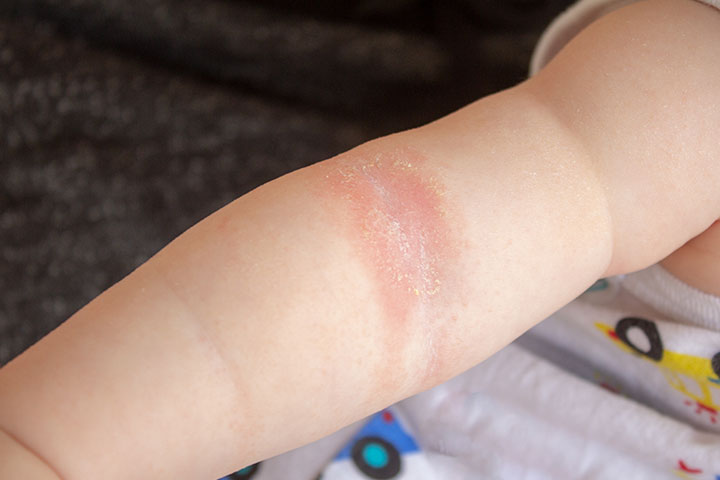An allergy is defined as a chronic skin condition that occurs due to the immune system’s abnormal response to an allergen or an unknown substance. Skin allergies in babies might be caused due to food, bites, stings, or adverse reactions to medicines (1). The common areas where allergies occur include the nose, skin, eyes, and digestive tract. In newborns, skin allergies usually manifest in the form of rashes, swelling, and itching of the skin (2). Read on to know more about the common skin allergies that can be seen in babies, their causes, symptoms, treatment, and prevention techniques.
Common Skin Allergies In Babies
Here we have listed some of the common types of skin allergies seen in babies.
- Eczema or atopic dermatitis
- Hives or urticaria
- Papular urticaria
- Contact dermatitis
- Angioedema
Each type of skin allergy has its own causes, medical management, and home remedies. Allergies may not always have a treatment but only a way to reduce the symptoms.
1. Atopic dermatitis or eczema
This chronic and relapsing inflammatory condition leads to itching and risks of skin infections. The most common parts of the skin to display the condition are the face and skin folds. Eczema affects about 10-20% of children in the US and Western Europe (3).
Symptoms
- Itchiness
- Rashes
- Tiny red bumps on face, forehead, scalp, and later on the torso (4)
- Dry skin
- Red bumps on the forearm, knees, and ankles in infants who crawl (5)
Causes
- Inhalant allergens: Some allergens are house dust (the most common allergen), grass pollen, and animal dander from pets.
- Skin irritants: A few common skin irritants that trigger allergies are woolens, nylon, acrylic material, excess soap in bubble baths, and heavily perfumed soaps, lotions, etc. (5)
- Food allergens: Less than 10% of babies exhibit a food item as a cause for eczema.
Medical management
The treatment of eczema focuses on the effective management of the condition and avoiding potential triggers. Do not provide any medicine to the baby without consulting the pediatrician.
- Topical corticosteroidsiXA group of steroid hormones produced in the adrenal cortex that are used for treatments in synthetic form to reduce inflammation.of different types could be used for the management of eczema.
- Topical immunosuppressantsiXDrugs that reduce and control the body’s immune response and prevent it from attacking its cells or tissues.could help address the symptoms of eczema, although more research is needed to prove efficacy (6).
- AntihistaminesiXMedications that relieve allergic symptoms.at bedtime are commonly prescribed for their sedative action to help relieve itching. More studies are needed to establish the safety and efficacy of antihistamines in babies (5).
However, the use of thick lubricant skin creams (non-medicated) may be useful. Also, avoiding rubbing the skin with a towel to dry it, touching it instead to absorb the water is quite useful.
Pediatrician and neonatologist Dr. Neema Shrestha says, “Regular use of moisturizers to maintain the skin barrier, minimizing hot and long showers, and avoiding exposure to the allergens that exacerbate the condition can help keep the symptoms under control. In case of eczema flares, visit the doctor to assess the need for a topical corticosteroid therapy and antihistamines.”
2. Hives
Hives, also known as urticaria, is a type of allergic rash triggered by the release of histamine and IgE in the body that happens in response to an allergic reaction (7). This superficial swelling can appear on any part of the body.
Symptoms
- Development of lesions, which are bumpy, red, warm, and swollen. These lesions are also called wheals (7).
- Lesions might have a pink or red outline with a pale center (8).
- They might range in size from the diameter of half an inch to several inches.
- They are generally very itchy (9).
Causes
Allergy to one or more of the following items could lead to hives (8).
- Milk
- Chocolate
- Shellfish Dust
- Mold
- Pets (pet dander and droppings)
- Medicines such as penicillin, sulfa drugs, ibuprofen, aspirin, antacidsiXMedications for indigestion and heartburn., eye and ear drops, laxatives, etc. (10)
- Certain viruses might causes hives as well
- Extreme temperatures
- In some cases there is no clear cause of hives
May, a stay-at-home mom of two, shares her account of her son’s hives outbreak, “Our boy started showing signs of food allergy when he turned ten months old. He came home one day from Grandpa’s with a bad hives breakout. For someone who loves food like he does, the need to be selective on his intake is almost a tragedy. The newest ingredient added to his porridge that day was anchovies, aka Ikan Bilis. We immediately accused these tiny common salt-water forage fish as the culprit.
“We removed anchovies in his diet and continued feeding him his usual Threadfin, which he had been consuming since month eight, by the way. Threadfin was his daily protein consumption, and he enjoyed it, too. Yet, after this episode, he couldn’t stomach Threadfin anymore. Only then did we find out that Threadfin was the guilty party for this awful allergic breakout (i).”
Treatment
Hives are usually self-limiting and do not need extensive medical intervention. The symptoms usually heal by themselves. but the itch may diminish exposing the skin to lukewarm water through a bath. Your pediatrician might prescribe topical calamine lotion or oral antihistamines, if necessary.
3. Papular Urticaria
It is a chronic inflammatory disease caused due to insect bites (11). Some common insects whose bites could cause papular urticaria are fleas, bedbugs, flies, mites, and ticks (12). According to the Asthma and Allergy Foundation of America, 5% of the US population is affected by insect allergies, and about 100 people in the US succumb to insect sting anaphylaxis annually.
Symptoms
- Itchy and wheal-like papules on the skin.
- The bumps might usually appear in clusters in a specific area.
- They might be filled with fluid (13).
- Lesions usually disappear in a few minutes or a few hours but, in some cases, may be chronic and recurrent.
Causes
The main cause for the papular urticaria is the body’s hypersensitive reaction to insect bites (13). Checking the baby’s room and crib for potential pests like bedbugs and mites could help identify the insect. In some instances the use of an appropiate insect repellent (safe for babies) may be useful.
Treatment
Papular urticaria is generally a self-limiting disease, and the symptoms subside eventually. Babies outgrow the disease. For severe itchiness, the doctor might prescribe topical corticosteroids or antihistamines.
4. Allergic contact dermatitis
It is a type of eczema that is triggered by skin contact with an allergen. Its prevalence is highest among babies up to the age of three years (14). Allergic contact dermatitis was earlier uncommon in babies, but there has been an increase in cases due to increased exposure to allergens at a young age (15).
Symptoms
- Mild to severe itchiness at the affected site.
- Red, dry, and scaly skin with visible borders.
- Fluid-filled sacs could also appear (16).
Causes
- Contact with metals like nickel, aluminum, cobalt, mercury, etc. Nickel is the most commonly identified metallic allergen.
- Rubber gloves used by the baby’s doctor or caretaker, while cleaning or examining the baby might also elicit an allergic response (17).
- Fragrances and dyes used in baby products might also be potential allergens.
Treatment
- Identification and removal of the allergen.
- Use of a moisturizer.
- Cool water soaks.
- Topical corticosteroids and antihistamines prescribed by a doctor for acute cases with intense irritation (18).
5. Angioedema
It is an allergic reaction that causes inflammation of deeper layers of the skin. It might occur along with hives or might manifest by itself (19).
Symptoms
- Inflammation can happen anywhere but is most prevalent around eyes, hands, feet, and mouth.
- Stomach cramps might occur.
- Severe cases might cause difficulty in breathing and swallowing due to the swelling of tissues.
Causes
Allergic reaction to one or more of the following might cause angioedema.
- Mold
- Food
- Dandler
- Pollen
- Drugs
- Insect bites
Very rarely, hereditary angioedema (HAE) is also seen. It might cause recurrent and severe allergic reactions, requiring immediate medical intervention. (20)
Management
- Identification and removal of the allergen.
- Regularly changing and washing the baby’s bed sheets, pillow covers, and blankets to get rid of dust.
- Severe cases might require medicines like antihistamines and corticosteroids prescribed by the doctor.
- HHome remedies like oatmeal bath and barrier creams containing lanoliniXAn oily material derived from sheep’s wool possessing antimicrobial properties. or cetomacrogoliXA non-greasy moisturizing agent used to heal dry skin problems such as eczema. might help. Consult a doctor before trying any home remedies.
Tips To Prevent Skin Allergies
The following are some ways to avoid skin allergies in babies (21).
- Identify and avoid the allergen to prevent recurrent infections.
- It is also recommended to avoid exposure to foods that have a high potential for allergy babies. It is good to consult a doctor before introducing foods such as eggs, fish, soy, etc.
- If the baby is confirmed to be allergic to a particular food, then a breastfeeding mother may consider avoiding the food.
- Keep pets and carpets clean to avoid allergies due to fleas and bed bugs.
- Avoid the baby’s exposure to metals like nickel, to avoid allergic contact dermatitis.
- Discuss with the pediatrician if you can keep any emergency medicines at home as a response to allergic reactions.
When To See A Doctor?
It is good to see a doctor when you notice symptoms, and you suspect the baby has a skin allergy. The doctor may recommend an epinephrine auto-injector to keep handy for anaphylactic shock, a condition where the baby has a severe allergic reaction.
Certain allergies, like hives, might be mild and occasional, seldom requiring prompt medical attention. However, if the condition occurs repeatedly or sustains for more than six weeks, then you must take the baby to a doctor (9).
Skin allergies in babies are not uncommon but may require medical attention if their frequency or severity increases. Allergies such as eczema, hives, papular urticaria, contact dermatitis, or angioedema may be triggered if the baby comes in contact with allergens such as dust, pollen, pet dander, insect bites, some metals, baby-care products, food, or even clothes. Babies may show reduced signs of allergy as they grow. Until then, identifying the allergen may help prevent subsequent episodes of allergy. However, you should see a doctor before treating your baby with over-the-counter topical or oral anti-allergy medications.
Key Pointers
- Eczema is a skin allergy that causes rashes and itching in babies.
- Hives, or urticaria, are skin swellings that can occur anywhere on the body.
- Insect bites cause papular urticaria, which appears as itchy, wheal-like papules.
- Allergic contact dermatitis is a skin response caused by allergen exposure.
- Angioedema is a swelling of deep skin tissues, usually around the eyes or mouth.
- Treatment of skin allergies in babies depends on the specific condition and involves topical creams, medications, and avoiding triggers.
- For prolonged or severe skin allergies, it is best to consult a pediatrician for proper diagnosis and management.















